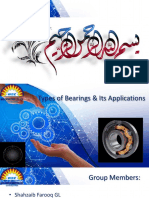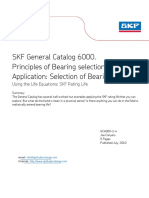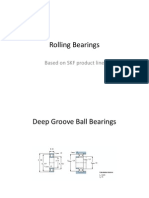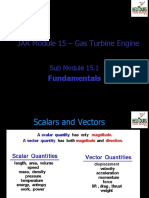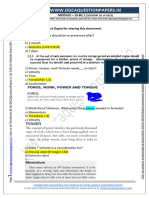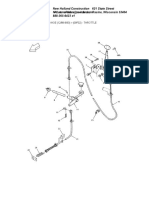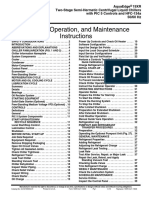Module 6 (Materials & Hardware) SubModule 6.8 (Bearings)
Uploaded by
daniaModule 6 (Materials & Hardware) SubModule 6.8 (Bearings)
Uploaded by
daniaPIA TRAINING CENTRE (PTC) Module 6 – MATERIALS & HARDWARE
Category – A/B1 Sub Module 6.8 – Bearings
MODULE 6
Sub Module 6.8
BEARINGS
ISO 9001 - 2008 Approved For Training Purpose Only
PTC/CM/B1.1 Basic/M06/01 Rev. 00
6.8 - i Mar 2014
PIA TRAINING CENTRE (PTC) Module 6 – MATERIALS & HARDWARE
Category – A/B1 Sub Module 6.8 – Bearings
Contents
PURPOSE OF BEARING ------------------------------------------------ 1
LOADS ----------------------------------------------------------------------- 1
TYPES AND APPLICATION OF BALL BEARING ----------------- 2
CONSTRUCTION OF BALL BEARINGS ---------------------------- 4
TYPES AND APPLICATION OF ROLLER BEARINGS ---------- 5
ISO 9001 - 2008 Approved For Training Purpose Only
PTC/CM/B1.1 Basic/M06/01 Rev. 00
6.8 - ii Mar 2014
PIA TRAINING CENTRE (PTC) Module 6 – MATERIALS & HARDWARE
Category – A/B1 Sub Module 6.8 – Bearings
PURPOSE OF BEARING
A bearing is any surface that supports or is supported by
another surface. It is a part in which a journal, pivot, pin or
similar device turns or revolves. The bearings used in aircraft
engines are designed to produce a minimum of friction and a
maximum of wear resistance.
Bearings are, broadly, classified by the type of rolling element
used in their construction. Ball bearings employ steel balls,
which rotate in grooved raceways, whilst Roller bearings utilise
cylindrical, tapered and spherical rollers running in suitably
shaped raceways (refer to Fig. 01).
Although these notes give information on the uses of the
various types of ball and roller bearings, - together with general
information on installation, maintenance and inspection, - the
Aircraft Maintenance Manual (AMM) should be the final arbiter
for specific installations.
LOADS
Ball and Roller Bearings
Ball bearings and tapered roller bearings accept both radial and
axial loads, whilst the other types of roller bearings may accept
Fig. 01
only radial loads.
ISO 9001 - 2008 Approved For Training Purpose Only
PTC/CM/B1.1 Basic/M06/01 Rev. 00
6.8 - 1 Mar 2014
PIA TRAINING CENTRE (PTC) Module 6 – MATERIALS & HARDWARE
Category – A/B1 Sub Module 6.8 – Bearings
Those bearings, which are contained in cages, are, in general, These points of contact created within the bearing will be
used for engine and gearbox applications with rotational speeds perpendicular to the shaft.
in excess of approximately 100 rpm. Most other bearings, on an
aircraft or in an engine, are intended for oscillating or slow
rotation conditions and do not have a cage. They are generally
shielded or sealed and pre-packed with grease, although some
have external lubrication facilities.
TYPES AND APPLICATION OF BALL BEARING
Ball Bearing is divided into 3 main groups
1. Radial bearings
2. Angular contact bearings Fig. 02 Radial Bearing
3. Thrust bearings
Radial Ball Bearing Angular Contact Ball Bearings
This is the most common type of rolling bearing and is found in Angular contact ball bearings are classified as single row, radial
all forms of transmission assemblies such as shafts, gears and ball bearings. These bearings are capable of accepting radial
control-rod end fittings. These bearings have one row of balls loads, and axial loads in one direction. However, many refer to
(referred to as a single row) that revolves around the ball path. them incorrectly as thrust bearings because they are designed
Although designed to primarily carry radial loads, a radial ball to carry a heavier axial load. The axial loading capacity of an
bearing’s raceways are deep enough that it can also carry angular contact bearing depends to a large extent on the
reasonable thrust loads. (However, if thrust loads are excessive, contact angle. To achieve the contact angle large radial internal
an alternative type of bearing should be considered.) Radial ball clearances are usually employed.
bearings are designed to carry primarily a radial load. When a
pure radial load is applied to the bearing, the balls settle to the
deepest point of the raceways and the load is transferred
through the rings and balls where they contact one another.
ISO 9001 - 2008 Approved For Training Purpose Only
PTC/CM/B1.1 Basic/M06/01 Rev. 00
6.8 - 2 Mar 2014
PIA TRAINING CENTRE (PTC) Module 6 – MATERIALS & HARDWARE
Category – A/B1 Sub Module 6.8 – Bearings
Unlike other radial ball bearings, the contact points through the
angular contact bearing are measured in terms of how far they
deviate from the normal pure radial load (at a 90° angle to the
shaft). Angular contact bearings are designed to operate with an
internal contact angle of 15°, 30° or 40° from the standard 90°
angle to the shaft.
In applications where axial loads will always be in one direction,
a single angular contact bearing may be used, but where axial
loads vary in direction an opposed pair of bearings is often
used, and adjusted to maintain the required axial clearance.
These bearings are designed for the balls to ride high on the
edge of the raceways. If the angular contact bearing is installed
facing the wrong direction, it will separate and result in a
catastrophic premature bearing failure. After an angular contact
bearing is installed, excessive end play, or the axial movement
of one ring in relationship to the other before subjected to any
external load, may lead to premature bearing failure.
Fig. 03 Angular contact bearing
The illustration to the right (labelled "Before") shows the shift
that occurs (Offset A and B), which is referred to as stick out. To
control endplay, the faces of the bearings are flush ground
aspictured in the illustration also to the right (labelled "After").
They may now be duplexes (see below). Maintaining this
controlled end play promotes good load sharing support by
each bearing, eliminating heat generation and power loss.
ISO 9001 - 2008 Approved For Training Purpose Only
PTC/CM/B1.1 Basic/M06/01 Rev. 00
6.8 - 3 Mar 2014
PIA TRAINING CENTRE (PTC) Module 6 – MATERIALS & HARDWARE
Category – A/B1 Sub Module 6.8 – Bearings
Duplex / Angular Contact Bearings
A particular type of angular contact bearing, known as a duplex
bearing, is fitted with a split inner or outer ring, and is designed
to take axial loads in either direction. The balls make contact
with two separate raceways in each ring, and one essential
condition of operation is that the bearing should never run
unloaded. The bearings are not adjustable, and radial loads
should always be lighter than axial loads. This is a most efficient
form of thrust bearing.
Thrust Ball Bearings
Thrust Ball Bearings are designed to carry a pure form of thrust
(axial) loads. When a load is properly applied to this bearing,
the internal contact points are aligned on a plane parallel to the Fig. 04 Thrust ball bearing
shaft. Radial loads will dislodge the balls from their track and
cause the bearing to separate. Thrust ball bearings are made in CONSTRUCTION OF BALL BEARINGS
two configurations, single direction and double direction
designs.
The bearings are manufactured with the balls in either single or
double rows, rigid for normal applications, or self-aligning for
positions where accurate alignment cannot be maintained. Such
bearings may also be provided with metal shields or synthetic
rubber seals to prevent the ingress of foreign matter and retain
the lubricant, and with a circlip groove or flange for retention
purposes. The balls are often retained in a cage, but in some
cases filling slots in the inner and outer rings permit individual
insertion of the balls, thus allowing a larger number of balls to
be used and giving the bearing a greater radial load capacity;
however, axial loads are limited due to the presence of the
raceway interruptions.
ISO 9001 - 2008 Approved For Training Purpose Only
PTC/CM/B1.1 Basic/M06/01 Rev. 00
6.8 - 4 Mar 2014
PIA TRAINING CENTRE (PTC) Module 6 – MATERIALS & HARDWARE
Category – A/B1 Sub Module 6.8 – Bearings
Cylindrical Roller Bearings
These bearings are capable of carrying greater radial loads than
ball bearings of similar external dimensions, due to the greater
contact area of the rolling elements. Bearings with ribs on both
rings will also carry light, intermittent, axial loads. However they
have the disadvantage of requiring almost perfect geometry of
the raceways and rollers.
Fig. 05 Parts of a ball bearing
TYPES AND APPLICATION OF ROLLER BEARINGS
Roller bearings may be divided into three main groups,
according to the shape of the rollers. They are:
1. Cylindrical
2. Spherical
3. Tapered Fig. 06 Cylindrical roller bearing
A slight misalignment will cause the rollers to skew and get out
of line. For this reason, the retainer must be heavy.
ISO 9001 - 2008 Approved For Training Purpose Only
PTC/CM/B1.1 Basic/M06/01 Rev. 00
6.8 - 5 Mar 2014
PIA TRAINING CENTRE (PTC) Module 6 – MATERIALS & HARDWARE
Category – A/B1 Sub Module 6.8 – Bearings
Straight Roller Bearing
The type of Straight roller bearing most commonly used is that
in which the diameter and length of the rollers are equal.
Bearings having rollers of a length greater than their diameter
are also used for special applications. These will not of cause
take thrust loads.
Needle Roller Bearing
A different kind of bearing in this category is the needle roller
bearing, in which the length of the rollers is several times Fig. 07 Straight Roller Bearing
greater than their diameter. These bearings are designed for
pure radial loads and are often used in locations where the For continuous rotation, needle bearings are usually suitable
movement is oscillatory rather than rotary, such as universal where the loading is intermittent and variable so that the
couplings and control-rod ends. Needle bearings are particularly needles will be frequently unloaded and thus tend to return to
useful in locations where space is limited, and are often their proper locations.
supplied as a cage and roller assembly, the shaft of the
components acting as the inner ring and inner surface of the Tapered Roller Bearings
housing as outer ring. The friction of needle bearings is several
times as great as for ordinary cylindrical roller bearing. Because These bearings are designed so that the axes of the rollers form
of the tendency of the unguided rollers to skew, the dimensions an angle with the shaft axis. They are capable of accepting
and surface finish of the shaft must be closely controlled to the simultaneous radial loads and axial loads in one direction, the
standards specified by the bearing manufacturer. proportions of the loads determining the taper angle. However,
even when an external thrust load is not present, the radial load
will induce a thrust reaction within the bearing because of the
taper. To avoid separation of the races and rollers, this thrust
must be resisted by an equal and opposite force. One way of
generating this force is to always use at least two tapered roller
bearings on shaft. These can be mounted with the cone backs
facing each other, in the configuration called direct Mounting or
with the cone fronts facing each other, in what is called indirect
ISO 9001 - 2008 Approved For Training Purpose Only
PTC/CM/B1.1 Basic/M06/01 Rev. 00
6.8 - 6 Mar 2014
PIA TRAINING CENTRE (PTC) Module 6 – MATERIALS & HARDWARE
Category – A/B1 Sub Module 6.8 – Bearings
Spherical Roller Bearings
mounting. Because the axial load on the rollers results in
rubbing contact on the cone rib, careful lubrication is essential, A spherical roller bearing may have one or two rows of spherical
particularly at high speeds. rollers, which run in a spherical raceway in the outer ring, thus
enabling the bearing to accept a minor degree of misalignment
between opposite bearings. The bearing is capable of
withstanding heavy radial loads, and moderate axial loads from
either direction. Thrust bearings can be constructed by the use
of straight or tapered rollers. Roller bearings are usually made
of casehardened steels. The carburized case or exterior should
have a hardness of 58-63 Rc. The core is softer with a hardness
of 25-40 Rc. Certain plain carbon and alloy steels have been
found suitable for roller bearing service. The maximum
temperature is limited to about 350° F. The separator, cage, or
retainer for conventional bearings is usually a stamping of low-
carbon steel. For higher speeds or precision service, the
separator is machined from a suitable copper alloy, such as
bronze. Cages are also made of a solid lubricant material for
use where conventional types of lubrication cannot be used.
Fig. 08 Tapered Roller Bearing
ISO 9001 - 2008 Approved For Training Purpose Only
PTC/CM/B1.1 Basic/M06/01 Rev. 00
6.8 - 7 Mar 2014
PIA TRAINING CENTRE (PTC) Module 6 – MATERIALS & HARDWARE
Category – A/B1 Sub Module 6.8 – Bearings
Group 2 (‘One Dot’) Bearings
Group 2 bearings have the smallest radial internal clearance
and are, normally, used in precision work, where minimum axial
and radial movement is required. These bearings should not be
used in applications where high temperatures could reduce the
internal clearance and are not suitable as thrust bearings nor for
high-speed situations.
Normal Group (‘Two Dot’) Bearings
Normal Group bearings are used for most general applications,
where only one ring, of the bearing race, is an interference fit
Fig. 09 Spherical Roller Bearing
and where no appreciable amount of heat, is likely to be
THE INTERNAL CLEARANCE OF THE BEARING transferred to the bearing.
In order to freely rotate, a ball bearing must have a certain Group 3 (‘Three Dot’) Bearings
amount of internal freedom of movement (internal clearance, or
the space between the raceway and ball). Without this internal Group 3 bearings have greater internal clearance than Normal
clearance, the bearing can be difficult to rotate or may even Group bearings and are employed where both race rings are
freeze-up and be impossible to rotate. On the other hand, too interference fits, or where one ring is an interference fit, and
much internal clearance will result in an unstable bearing that some transfer of heat must be accepted. These bearings are
may generate excessive noise or allow the shaft to wobble. It is also used for high speed and in applications where axial
therefore imperative that the bearing be manufactured with the loadings are predominant.
proper amount of measured internal clearance to meet the
needs of the application. Loads are applied to the bearing both
from the axial and radial directions; likewise, the internal
clearance is measured in terms of the direction of the load
(radial internal clearance and axial internal clearance). When
manufactured and not yet shaft mounted, the bearing is
measured in terms of its un-mounted internal clearance.
ISO 9001 - 2008 Approved For Training Purpose Only
PTC/CM/B1.1 Basic/M06/01 Rev. 00
6.8 - 8 Mar 2014
PIA TRAINING CENTRE (PTC) Module 6 – MATERIALS & HARDWARE
Category – A/B1 Sub Module 6.8 – Bearings
Group 4 (‘Four Dot’) Bearings 5. Deep-groove ball bearings are available with seals built
into the bearing so that the bearing can be pre lubricated
to operate for long periods without attention.
Group 4 bearings have the greatest internal clearance and are
found where both rings are interference fits and where the MOUNTING AND ENCLOSURE OF BEARINGS
transfer of heat reduces internal clearances.
There are so many methods of mounting antifriction bearings
Standard bearings are produced in all four groups while that each new design is a real challenge to the ingenuity of the
instrument precision bearings are supplied only in the first three designer. The housing bore and shaft outside diameter must be
groups. held to very close limits, which of course is expensive. There
are usually one or more Counter boring operations several
facing operations and drilling, tapping, and threading
SELECTING BEARINGS
operations, all of which must be performed on the shaft,
housing, or cover plate. Each of these operations contributes to
Some guidelines for selecting bearings can be summarized as the cost of production, so that the designer, in ferreting out a
follows: trouble-free and low-cost mounting, is faced with a difficult and
important problem. The various bearing manufacturers'
1. Ball bearings are the less expensive choice in the handbooks give many mounting details in almost every design
smaller sizes and under lighter loads while roller area. In a text of this nature, however, it is possible to give only
bearings are less expensive for larger sizes and heavier the barest details. The most frequently encountered mounting
loads. problem is that which requires one bearing at each end of a
shaft. Such a design might use one ball bearing at each end;
2. Roller bearings are more satisfactory under shock or one tapered roller bearing at each end, or a ball bearing at one
impact loading than ball bearings. end and a straight roller bearing at the other. One of
thebearings usually has the added function of positioning or
3. Ball-thrust bearings are for pure thrust loading only. At axially locating the shaft. Figure below shows a very common
high speeds, a deep-groove or angular-contact ball solution to this problem. The inner rings are backed up against
bearing usually will be a better choice, even for pure the shaft shoulders and are held in position by round nuts
thrust loads. threaded ontothe shaft. The outer ring of the left-hand bearing is
backed up against a housing shoulder and is held in position by
4. Self-aligning ball bearings and cylindrical roller bearings a device, which is not shown. The outer ring of the right-hand
have very low friction coefficients.
ISO 9001 - 2008 Approved For Training Purpose Only
PTC/CM/B1.1 Basic/M06/01 Rev. 00
6.8 - 9 Mar 2014
PIA TRAINING CENTRE (PTC) Module 6 – MATERIALS & HARDWARE
Category – A/B1 Sub Module 6.8 – Bearings
bearing floats in the housing. There are many variations by the cover plate, but if no thrust is present, the ring may be
possible on the method shown in Figure below. held in place by retaining rings.
BEARING MAINTENANCE
Ball and roller bearings, if properly lubricated and installed, have
a long life and require little attention. Bearing failures may have
serious results and, to avoid such problems, Aircraft
Maintenance Manuals and approved Maintenance Schedules
include full lubrication and inspection instructions, which MUST
be followed in order to limit the likelihood of bearing failure.
Lubrication:
As has already been stated, most bearings, used in airframe
applications, are shielded (sealed) to prevent the entry of dirt or
fluids, which could affect bearing life. These cannot, normally,
be re-greased and must be replaced if there are signs of wear,
loss of lubricant or brinelling. (brinelling is the indentation of the
Fig. 10 surfaces of the bearing races).
For example, the function of the shaft shoulder may be
In some places, where there is risk of loss of lubricant, a grease
performed by retaining rings, by the hub of a gear or pulley, or
by spacing tubes or rings. The round nuts may be replaced by nipple will be provided to permit recharging with fresh grease.
retaining rings or by washers locked in position by screws, Greasing should only be done after the nipple has been wiped
cotters, or taper pins. The housing shoulder may be replaced by clean of all dirt and, on completion, all excess grease must be
a retaining ring; the outer ring of the bearing may be grooved for wiped away with a clean cloth.
a retaining ring, or a flanged outer ring may be used. The force
against the outer ring of the left-hand bearing is usually applied
ISO 9001 - 2008 Approved For Training Purpose Only
PTC/CM/B1.1 Basic/M06/01 Rev. 00
6.8 - 10 Mar 2014
PIA TRAINING CENTRE (PTC) Module 6 – MATERIALS & HARDWARE
Category – A/B1 Sub Module 6.8 – Bearings
Inspection:
Bearings are designed to operate with little or no maintenance,
but they must be inspected regularly because, if corrosion or
wear begins, the bearing will deteriorate rapidly. Bearings are
usually inspected without removing them from the component
(in situ), as continued removal and installation of bearings can
cause wear and damage.
Wheel bearings are inspected when the wheel is returned to the
Wheel Servicing Bay for maintenance. Other items might also
be inspected when their major assembly is removed for ‘off-
aircraft’ maintenance.
‘On-aircraft’ checks can include checking for smoothness of
operation, for wear (by moving the assembly both axially and
radially) and also for any signs of interference or fouling with (or
from) adjacent components.
ISO 9001 - 2008 Approved For Training Purpose Only
PTC/CM/B1.1 Basic/M06/01 Rev. 00
6.8 - 11 Mar 2014
You might also like
- 1401-0310-024-11 - Service Manual System Sophi and Sophi ANo ratings yet1401-0310-024-11 - Service Manual System Sophi and Sophi A78 pages
- D.T.D.900AA: Ministry of Defence Defence Procurement Agency, ADRP2 Abbey Wood Bristol BS34 8JHNo ratings yetD.T.D.900AA: Ministry of Defence Defence Procurement Agency, ADRP2 Abbey Wood Bristol BS34 8JH24 pages
- Hydraulic and Pneumatic Power Systems FAA Questions (A8)No ratings yetHydraulic and Pneumatic Power Systems FAA Questions (A8)6 pages
- Bhausaheb Vartak Polytechnic: A Presentation ON Bearing Prepared by Akash Panchal S.Y.P.T - 1429No ratings yetBhausaheb Vartak Polytechnic: A Presentation ON Bearing Prepared by Akash Panchal S.Y.P.T - 142951 pages
- Elastomeric Seals and Materials at Cryogenic TemeraturesNo ratings yetElastomeric Seals and Materials at Cryogenic Temeratures81 pages
- Design Guide - O-Ring, Quad-Ring, TrelleborgNo ratings yetDesign Guide - O-Ring, Quad-Ring, Trelleborg32 pages
- A4 Fuel Metering System - Muhammadh Maihan Nazim - 6bme1 - 53211219102No ratings yetA4 Fuel Metering System - Muhammadh Maihan Nazim - 6bme1 - 532112191024 pages
- Civil Aviation Requirements Section 2 - Airworthiness Series 'O' Part Vi 14 JULY, 1993 Effective: ForthwithNo ratings yetCivil Aviation Requirements Section 2 - Airworthiness Series 'O' Part Vi 14 JULY, 1993 Effective: Forthwith18 pages
- Amt 646 Midterm 1 Reciprocating Engine LubricationNo ratings yetAmt 646 Midterm 1 Reciprocating Engine Lubrication48 pages
- Turbine Engine Operation, Maintenance, Inspection, and OverhaulNo ratings yetTurbine Engine Operation, Maintenance, Inspection, and Overhaul27 pages
- Unit 2 Plastics and Composites in AircraftNo ratings yetUnit 2 Plastics and Composites in Aircraft28 pages
- M o D U L e 0 6 - 0 3 - 0 1 A Materials and HardwareNo ratings yetM o D U L e 0 6 - 0 3 - 0 1 A Materials and Hardware32 pages
- Module 6 (Materials & Hardware) SubModule 6.10 (Control CablNo ratings yetModule 6 (Materials & Hardware) SubModule 6.10 (Control Cabl20 pages
- Module 6 (Materials & Hardware) SubModule 6.5 (Fasteners)No ratings yetModule 6 (Materials & Hardware) SubModule 6.5 (Fasteners)75 pages
- Module 6 (Materials & Hardware) SubModule 6.6 (Pipes and UniNo ratings yetModule 6 (Materials & Hardware) SubModule 6.6 (Pipes and Uni22 pages
- Module 6 (Materials & Hardware) SubModule 6.4 (Corrosion)No ratings yetModule 6 (Materials & Hardware) SubModule 6.4 (Corrosion)26 pages
- PTC A, B1.1 & B2 Basic Notes - Sub Module 8.4 (Flight StabilNo ratings yetPTC A, B1.1 & B2 Basic Notes - Sub Module 8.4 (Flight Stabil25 pages
- Module 6 (Materials & Hardware) SubModule 6.3 (Aircraft MateNo ratings yetModule 6 (Materials & Hardware) SubModule 6.3 (Aircraft Mate70 pages
- Module 6 (Materials & Hardware) SubModule 6.2 (Aircraft MateNo ratings yetModule 6 (Materials & Hardware) SubModule 6.2 (Aircraft Mate25 pages
- Module 9 (Human Factors) Sub Module 9.1 (INTRODUCTION TO HUMNo ratings yetModule 9 (Human Factors) Sub Module 9.1 (INTRODUCTION TO HUM25 pages
- PTC A, B1.1 & B2 Basic Notes - Sub Module 8.3 (Theory of FliNo ratings yetPTC A, B1.1 & B2 Basic Notes - Sub Module 8.3 (Theory of Fli49 pages
- PTC A, B1.1 & B2 Basic Notes - Sub Module 8.2 (Aerodynamics)No ratings yetPTC A, B1.1 & B2 Basic Notes - Sub Module 8.2 (Aerodynamics)56 pages
- HughesNet AN8-074R .74m KA-Band Antenna - Pointing GuideNo ratings yetHughesNet AN8-074R .74m KA-Band Antenna - Pointing Guide56 pages
- Littelfuse Introduces Compact High Reliability Low Capacitance TVS Diode Series for AvionicsNo ratings yetLittelfuse Introduces Compact High Reliability Low Capacitance TVS Diode Series for Avionics4 pages
- Philips Catalog Luminaires Indoor CEE 2015No ratings yetPhilips Catalog Luminaires Indoor CEE 2015323 pages
- Throttle & Foot Accelerator Controls, (11-88/-), 455c & 455dNo ratings yetThrottle & Foot Accelerator Controls, (11-88/-), 455c & 455d2 pages
- An Insight Into Single Section Digital Axle Counter (SSDAC-G36)100% (1)An Insight Into Single Section Digital Axle Counter (SSDAC-G36)52 pages
- Engine Service Specifications: © 1998-2009 American Honda Motor Co., Inc. - All Rights Reserved AHM0% (1)Engine Service Specifications: © 1998-2009 American Honda Motor Co., Inc. - All Rights Reserved AHM42 pages
- 2011 NINJA 250R Parts Diagram: CarburetorNo ratings yet2011 NINJA 250R Parts Diagram: Carburetor3 pages
- tb67h451fng Application Note en 20201126No ratings yettb67h451fng Application Note en 2020112622 pages
- 007 (Update, Po Belum) - ST-Q PT - ARTAJAYA - Ejf IndoramaNo ratings yet007 (Update, Po Belum) - ST-Q PT - ARTAJAYA - Ejf Indorama1 page
- Variable Speed Electric Chain Hoist: Operating, Maintenance & Parts ManualNo ratings yetVariable Speed Electric Chain Hoist: Operating, Maintenance & Parts Manual68 pages
- Samsung Rf-263be Rf-263te Fast Track Troubleshooting100% (1)Samsung Rf-263be Rf-263te Fast Track Troubleshooting8 pages
- Attachment Document FAT For Junction Box - IFINo ratings yetAttachment Document FAT For Junction Box - IFI14 pages
- 1401-0310-024-11 - Service Manual System Sophi and Sophi A1401-0310-024-11 - Service Manual System Sophi and Sophi A
- D.T.D.900AA: Ministry of Defence Defence Procurement Agency, ADRP2 Abbey Wood Bristol BS34 8JHD.T.D.900AA: Ministry of Defence Defence Procurement Agency, ADRP2 Abbey Wood Bristol BS34 8JH
- Hydraulic and Pneumatic Power Systems FAA Questions (A8)Hydraulic and Pneumatic Power Systems FAA Questions (A8)
- Bhausaheb Vartak Polytechnic: A Presentation ON Bearing Prepared by Akash Panchal S.Y.P.T - 1429Bhausaheb Vartak Polytechnic: A Presentation ON Bearing Prepared by Akash Panchal S.Y.P.T - 1429
- Elastomeric Seals and Materials at Cryogenic TemeraturesElastomeric Seals and Materials at Cryogenic Temeratures
- A4 Fuel Metering System - Muhammadh Maihan Nazim - 6bme1 - 53211219102A4 Fuel Metering System - Muhammadh Maihan Nazim - 6bme1 - 53211219102
- Civil Aviation Requirements Section 2 - Airworthiness Series 'O' Part Vi 14 JULY, 1993 Effective: ForthwithCivil Aviation Requirements Section 2 - Airworthiness Series 'O' Part Vi 14 JULY, 1993 Effective: Forthwith
- Amt 646 Midterm 1 Reciprocating Engine LubricationAmt 646 Midterm 1 Reciprocating Engine Lubrication
- Turbine Engine Operation, Maintenance, Inspection, and OverhaulTurbine Engine Operation, Maintenance, Inspection, and Overhaul
- M o D U L e 0 6 - 0 3 - 0 1 A Materials and HardwareM o D U L e 0 6 - 0 3 - 0 1 A Materials and Hardware
- Module 6 (Materials & Hardware) SubModule 6.10 (Control CablModule 6 (Materials & Hardware) SubModule 6.10 (Control Cabl
- Module 6 (Materials & Hardware) SubModule 6.5 (Fasteners)Module 6 (Materials & Hardware) SubModule 6.5 (Fasteners)
- Module 6 (Materials & Hardware) SubModule 6.6 (Pipes and UniModule 6 (Materials & Hardware) SubModule 6.6 (Pipes and Uni
- Module 6 (Materials & Hardware) SubModule 6.4 (Corrosion)Module 6 (Materials & Hardware) SubModule 6.4 (Corrosion)
- PTC A, B1.1 & B2 Basic Notes - Sub Module 8.4 (Flight StabilPTC A, B1.1 & B2 Basic Notes - Sub Module 8.4 (Flight Stabil
- Module 6 (Materials & Hardware) SubModule 6.3 (Aircraft MateModule 6 (Materials & Hardware) SubModule 6.3 (Aircraft Mate
- Module 6 (Materials & Hardware) SubModule 6.2 (Aircraft MateModule 6 (Materials & Hardware) SubModule 6.2 (Aircraft Mate
- Module 9 (Human Factors) Sub Module 9.1 (INTRODUCTION TO HUMModule 9 (Human Factors) Sub Module 9.1 (INTRODUCTION TO HUM
- PTC A, B1.1 & B2 Basic Notes - Sub Module 8.3 (Theory of FliPTC A, B1.1 & B2 Basic Notes - Sub Module 8.3 (Theory of Fli
- PTC A, B1.1 & B2 Basic Notes - Sub Module 8.2 (Aerodynamics)PTC A, B1.1 & B2 Basic Notes - Sub Module 8.2 (Aerodynamics)
- HughesNet AN8-074R .74m KA-Band Antenna - Pointing GuideHughesNet AN8-074R .74m KA-Band Antenna - Pointing Guide
- Littelfuse Introduces Compact High Reliability Low Capacitance TVS Diode Series for AvionicsLittelfuse Introduces Compact High Reliability Low Capacitance TVS Diode Series for Avionics
- Throttle & Foot Accelerator Controls, (11-88/-), 455c & 455dThrottle & Foot Accelerator Controls, (11-88/-), 455c & 455d
- An Insight Into Single Section Digital Axle Counter (SSDAC-G36)An Insight Into Single Section Digital Axle Counter (SSDAC-G36)
- Engine Service Specifications: © 1998-2009 American Honda Motor Co., Inc. - All Rights Reserved AHMEngine Service Specifications: © 1998-2009 American Honda Motor Co., Inc. - All Rights Reserved AHM
- 007 (Update, Po Belum) - ST-Q PT - ARTAJAYA - Ejf Indorama007 (Update, Po Belum) - ST-Q PT - ARTAJAYA - Ejf Indorama
- Variable Speed Electric Chain Hoist: Operating, Maintenance & Parts ManualVariable Speed Electric Chain Hoist: Operating, Maintenance & Parts Manual
- Samsung Rf-263be Rf-263te Fast Track TroubleshootingSamsung Rf-263be Rf-263te Fast Track Troubleshooting








